PHILIPS 💙
PHILIPS
Redesign the B2B experience using a service blueprint.
Redesign the B2B experience using a service blueprint.
At Philips, I was tasked to improve the customer experience of a B2B eCommerce platform which was built based on the existing eCommerce platform from different business areas. This platform is to serve retailers and reduce manual processes such as ordering products and renewing contracts.
My initial finds after a discovery review were that the complex backend systems and fragmented offline processes result in broken user experiences. The users are frustrated and Philips are losing business.
At Philips, I was tasked to improve the customer experience of a B2B eCommerce platform which was built based on the existing eCommerce platform from different business areas. This platform is to serve retailers and reduce manual processes such as ordering products and renewing contracts.
My initial finds after a discovery review were that the complex backend systems and fragmented offline processes result in broken user experiences. The users are frustrated and Philips are losing business.
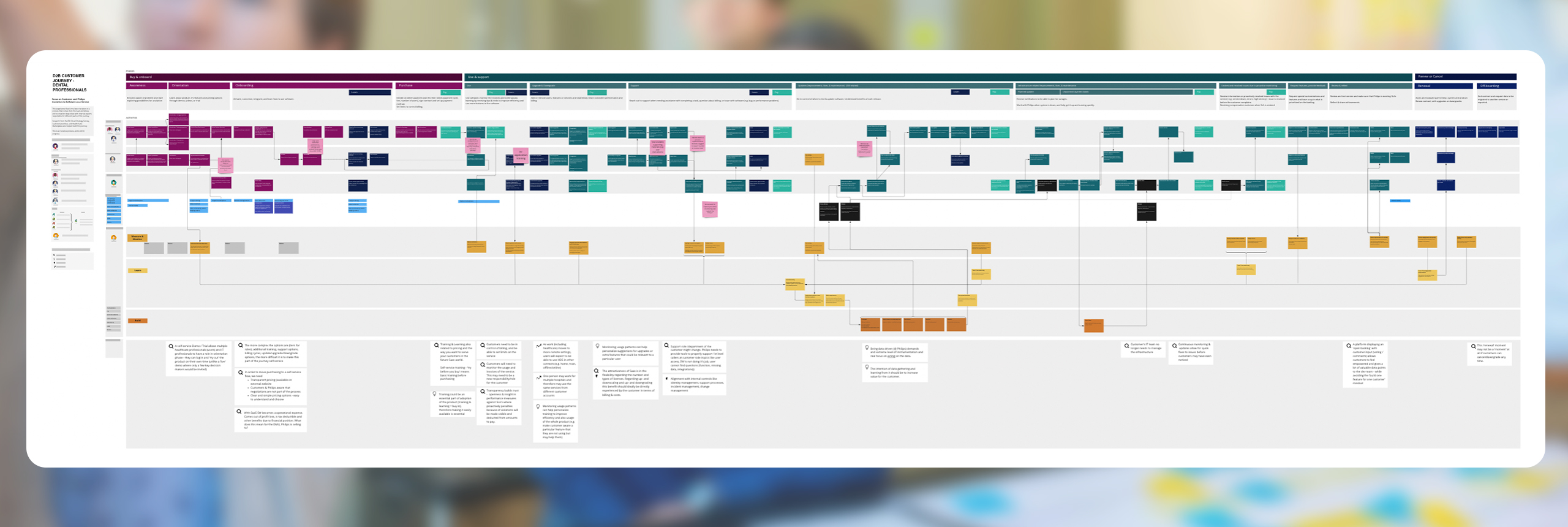
THE CHALLENGE
Defining a strategy.
Building empathy.
Defining a strategy.
I was asked to define the areas of opportunity, with the freedom to identify where to focus first. Due to the poorly integrated back-end system and unclear offline processes, I was starting from a position where the knowledge in the Philips teams was very fragmented. Lacking visibility of a clear end-to-end data flow and process was holding the product team back from making cohesive experience improvements. I prioritised starting with the creation of a service blueprint, this would enable me to collaboratively map the existing service - and identify the friction points and opportunities. In my experience, making a service blueprint is not only about the artefact itself but also about the team, the method, and the impact that can be created in the business.
Making a service blueprint requires me to talk to people who deliver key aspects of a service and quickly get a sense of what the business thinks its customers are going through. This doesn't require that I understand what they do in absolute detail. The task is to explain why and what I'm doing, and work together to paint a picture of the existing process and identify ideal requirements. I bring non-designers on board to map with me and most importantly engage them in using the blueprint to re-design the experience together.
I was asked to develop a new brand identity that reflects Portman Dental groups’s visions and values but talks directly to an younger audience seeking orthodontic treatment. Portman’s vision is to be the best privately focused dental group in the world.
I was asked to define the areas of opportunity, with the freedom to identify where to focus first. Due to the poorly integrated back-end system and unclear offline processes, I was starting from a position where the knowledge in the Philips teams was very fragmented. Lacking visibility of a clear end-to-end data flow and process was holding the product team back from making cohesive experience improvements. I prioritised starting with the creation of a service blueprint, this would enable me to collaboratively map the existing service - and identify the friction points and opportunities. In my experience, making a service blueprint is not only about the artefact itself but also about the team, the method, and the impact that can be created in the business.
Making a service blueprint requires me to talk to people who deliver key aspects of a service and quickly get a sense of what the business thinks its customers are going through. This doesn't require that I understand what they do in absolute detail. The task is to explain why and what I'm doing, and work together to paint a picture of the existing process and identify ideal requirements. I bring non-designers on board to map with me and most importantly engage them in using the blueprint to re-design the experience together.
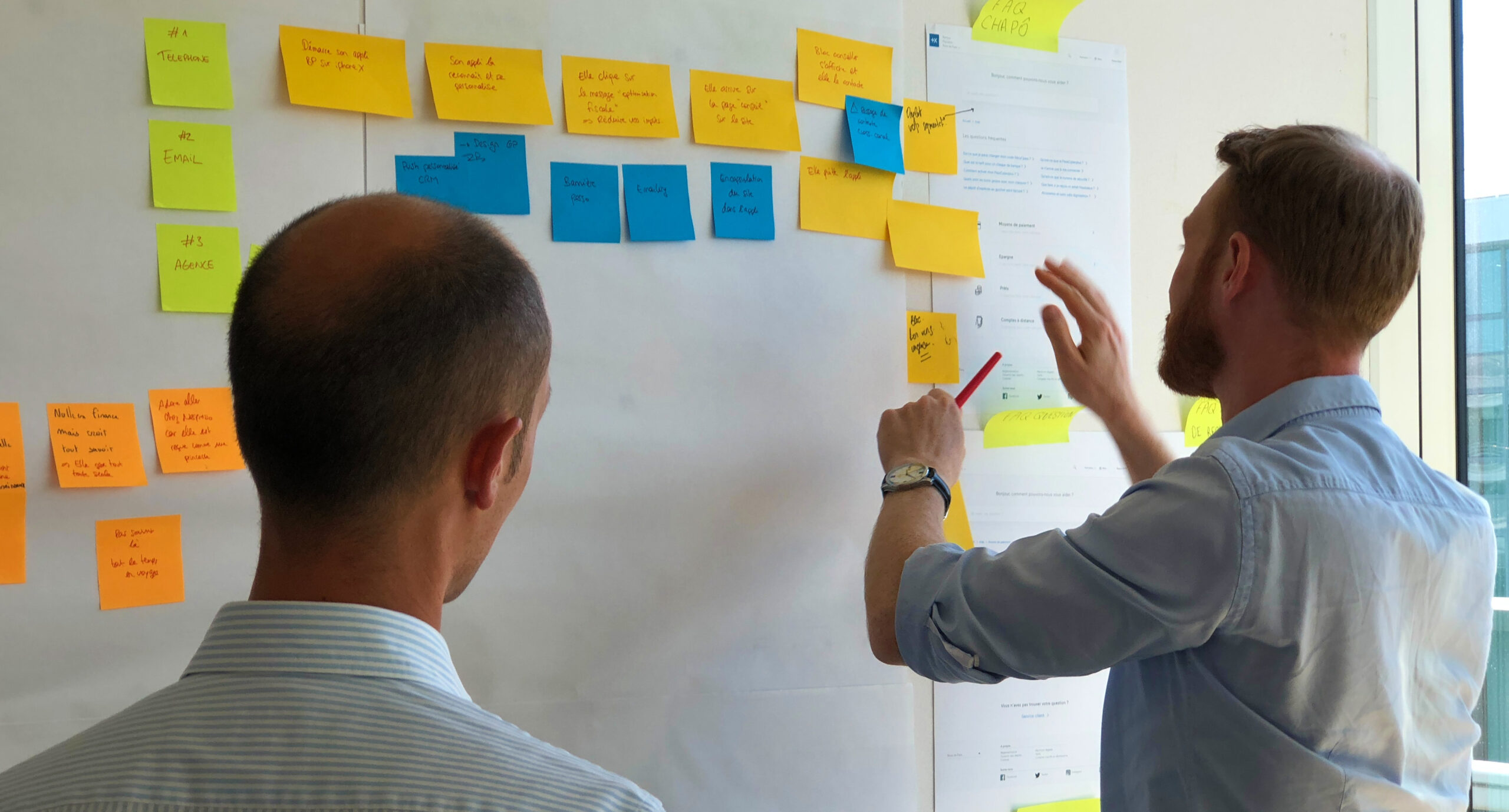
Different subject matter experts in the business joined me to fill the gaps on my map.
Different subject matter experts in the business joined me to fill the gaps on my map.
INTERNAL ACTOR INTERVIEW
INTERNAL ACTOR INTERVIEW
Expert time.
Expert time.
To kickstart the blueprint, I needed mostly high-level inputs from the subject matter experts within different departments who knew the specifics of their units, as well as those who had high-level views of the business.
In readiness, for these discussions, I spent time with the product owner creating a journey map based on the typical customer persona, including the user touchpoints and the related actions.
Then I spoke to the subject matter experts individually, asking questions such as:
- How does a customer sign up? Then what happens?
- Who makes that happen? Is that a team or an individual? When? How?
- Is there a human triggering the process or is it automatic?
- From which system do we attain this information? Why? Is it effective?
- Where does the data go after a customer sends it to us? How do we use it?
I further uncovered each segment of the user journey by adding detail that enabled me to dig deeper into what's happening in the background with each interaction. These experts often pointed me in the right direction when they didn't know about something, explaining "if you need to know more about XYZ, speak to this and this person".
That said, it’s not always the head of the department that brings the most value to mapping sessions. I found on this project for example that a data architect or business analyst sometimes gave a better overview of how data flows than the head of engineering.
To kickstart the blueprint, I needed mostly high-level inputs from the subject matter experts within different departments who knew the specifics of their units, as well as those who had high-level views of the business.
In readiness, for these discussions, I spent time with the product owner creating a journey map based on the typical customer persona, including the user touchpoints and the related actions.
Then I spoke to the subject matter experts individually, asking questions such as:
- How does a customer sign up? Then what happens?
- Who makes that happen? Is that a team or an individual? When? How?
- Is there a human triggering the process or is it automatic?
- From which system do we attain this information? Why? Is it effective
- Where does the data go after a customer sends it to us? How do we use it?
I further uncovered each segment of the user journey by adding detail that enabled me to dig deeper into what's happening in the background with each interaction. These experts often pointed me in the right direction when they didn't know about something, explaining "if you need to know more about XYZ, speak to this and this person".
That said, it’s not always the head of the department that brings the most value to mapping sessions. I found on this project for example that a data architect or business analyst sometimes gave a better overview of how data flows than the head of engineering.
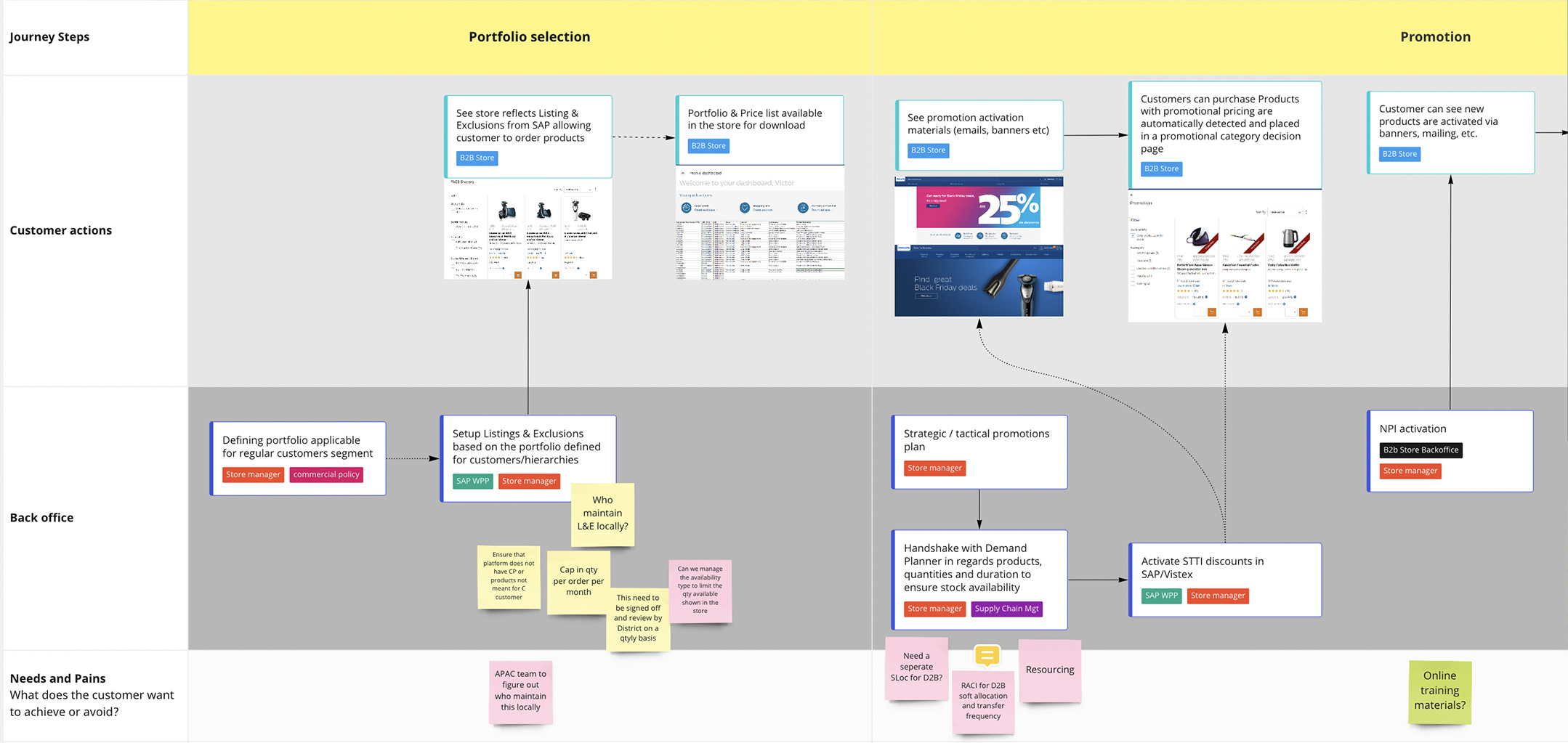
A high-level customer journey map is the starting point. I used this to start to move downward in columns and capture frontstage and backstage actions.
A high-level customer journey map is the starting point. I use this to start to move downward in columns and capture frontstage and backstage actions.
FIRST DRAFT
FIRST DRAFT
Putting the puzzles together.
Putting the puzzles together.
During the interview sessions, I gathered many useful materials such as data flow charts, Miroboards and spreadsheets. To process this information together into an end-to-end map I rolled out a big piece of paper on the wall in the office where my team is located. This was also a good way to increase visibility and promote my project to the wider teams.
I then started to create a low-fidelity version of the blueprint of the existing service. Once I had the draft of a flow, I invited stakeholders and peers early and often to validate it. And as Philips' teams are spread across a variety of locations globally, it's also essential to create a digital version of the map for better distribution and collaborations.
Soon after the first draft of the blueprint was done, the Product Owner asked me if he could use it in a business pitch to the Asian Pacific team. The service blueprint was an effective tool to get other teams on board and help them build their strategies. Although at this stage the blueprint was not fully complete, it was rewarding to see it already bringing a positive impact to the business.
During the interview sessions, I gathered many useful materials such as data flow charts, Miroboards and spreadsheets. To process this information together into an end-to-end map I rolled out a big piece of paper on the wall in the office where my team is located. This was also a good way to increase visibility and promote my project to the wider teams.
I then started to create a low-fidelity version of the blueprint of the existing service. Once I had the draft of a flow, I invited stakeholders and peers early and often to validate it. And as Philips' teams are spread across a variety of locations globally, it's also essential to create a digital version of the map for better distribution and collaborations.
Soon after the first draft of the blueprint was done, the Product Owner asked me if he could use it in a business pitch to the Asian Pacific team. The service blueprint was an effective tool to get other teams on board and help them build their strategies. Although at this stage the blueprint was not fully complete, it was rewarding to see it already bringing a positive impact to the business.
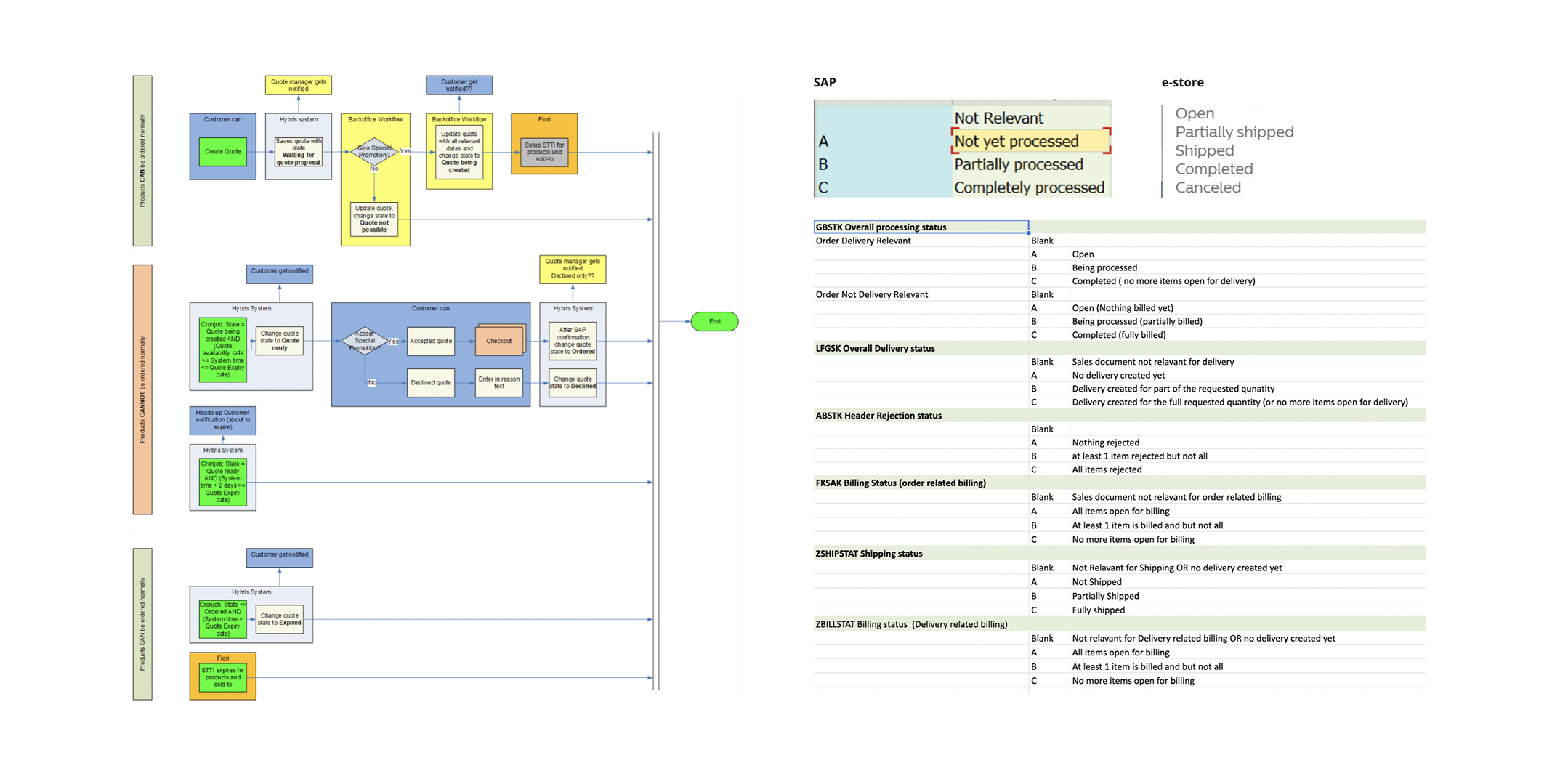
The existing documentation is fragmented. This blueprint joins these dots and presents a holistic picture of our services.
The existing documentation is fragmented. This blueprint joins these dots and presents a holistic picture of our services.
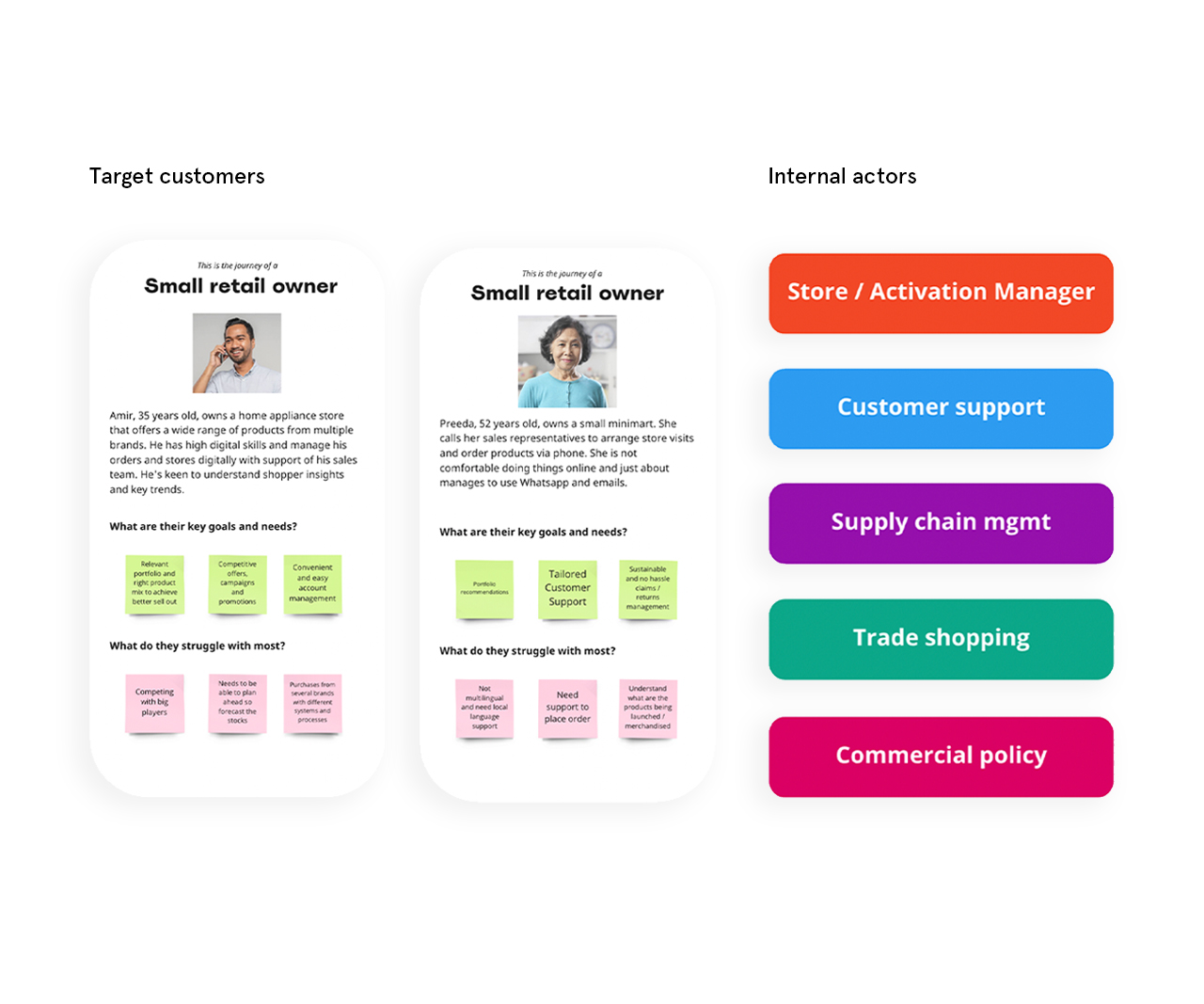
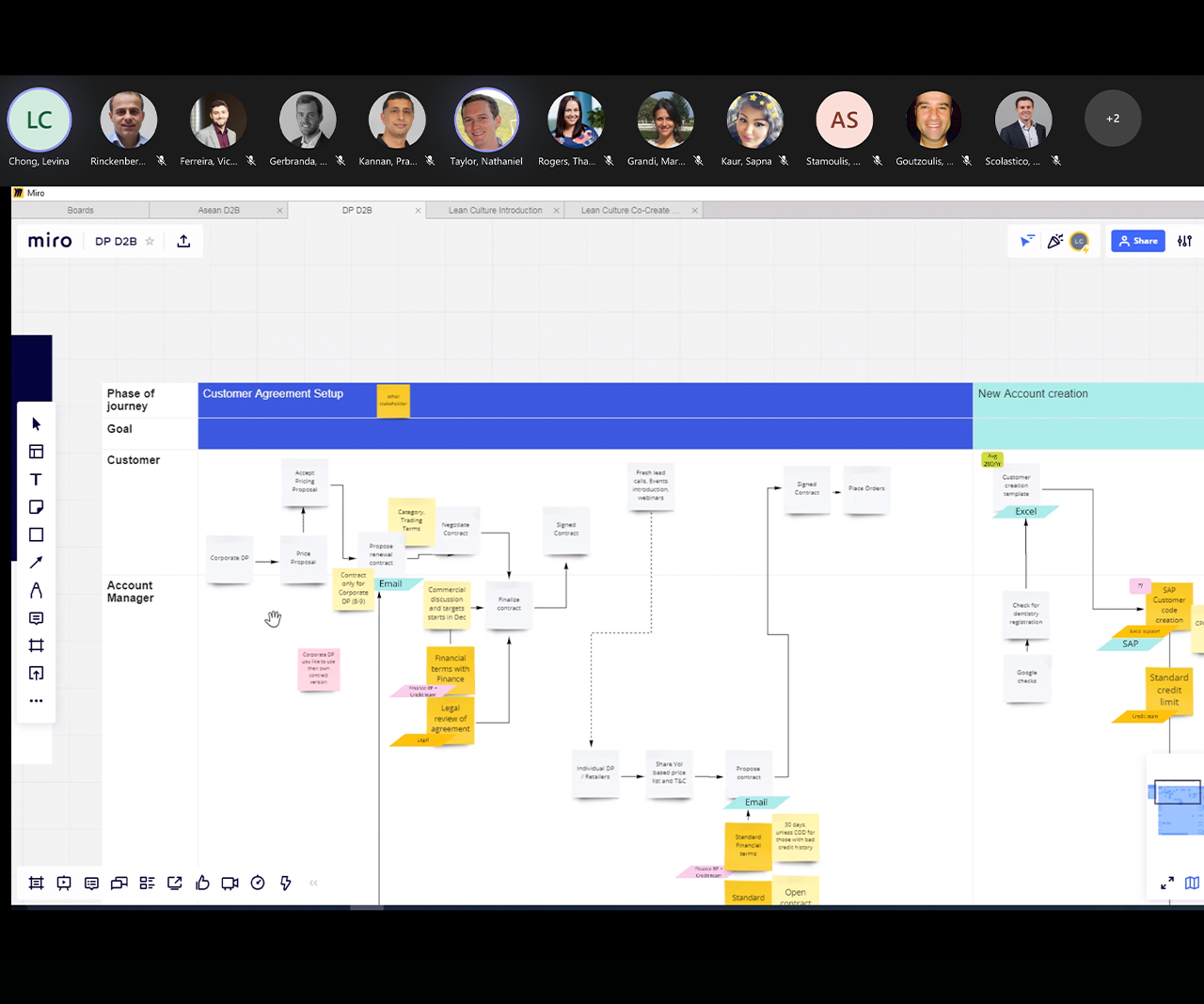
QUALITATIVE AND QUANTITATIVE DATA
QUALITATIVE AND QUANTITATIVE DATA
User insights.
Build a navigation system
for easy access to the tools.
User insights.
A service blueprint is not an experience map or a customer journey map – it does not hold detailed user insights. Although my first version of the blueprint displays key customer actions, it does not hold qualitative information about them. For example, it does not contain the hypothetical frustration of waiting for their quotation to arrive or the confusion created by the order status email.
Therefore I started digging into the customer feedback by reviewing all the data that has been collected from the on-site and post-purchase feedback forms and from the sales representatives.
I also connected with the regional customer support representative to set up interview sessions with a selection of customers who were willing to share their experiences with me.
Pairing the service blueprint with these insights, I started to have conversations about the qualitative aspects of the experience and show the factual processed data on the blueprint where appropriate— ensuring business and customer interests are discussed at the same time.
A service blueprint is not an experience map or a customer journey map – it does not hold detailed user insights. Although my first version of the blueprint displays key customer actions, it does not hold qualitative information about them. For example, it does not contain the hypothetical frustration of waiting for their quotation to arrive or the confusion created by the order status email.
Therefore I started digging into the customer feedback by reviewing all the data that has been collected from the on-site and post-purchase feedback forms and from the sales representatives.
I also connected with the regional customer support representative to set up interview sessions with a selection of customers who were willing to share their experiences with me.
Pairing the service blueprint with these insights, I started to have conversations about the qualitative aspects of the experience and show the factual processed data on the blueprint where appropriate— ensuring business and customer interests are discussed at the same time.
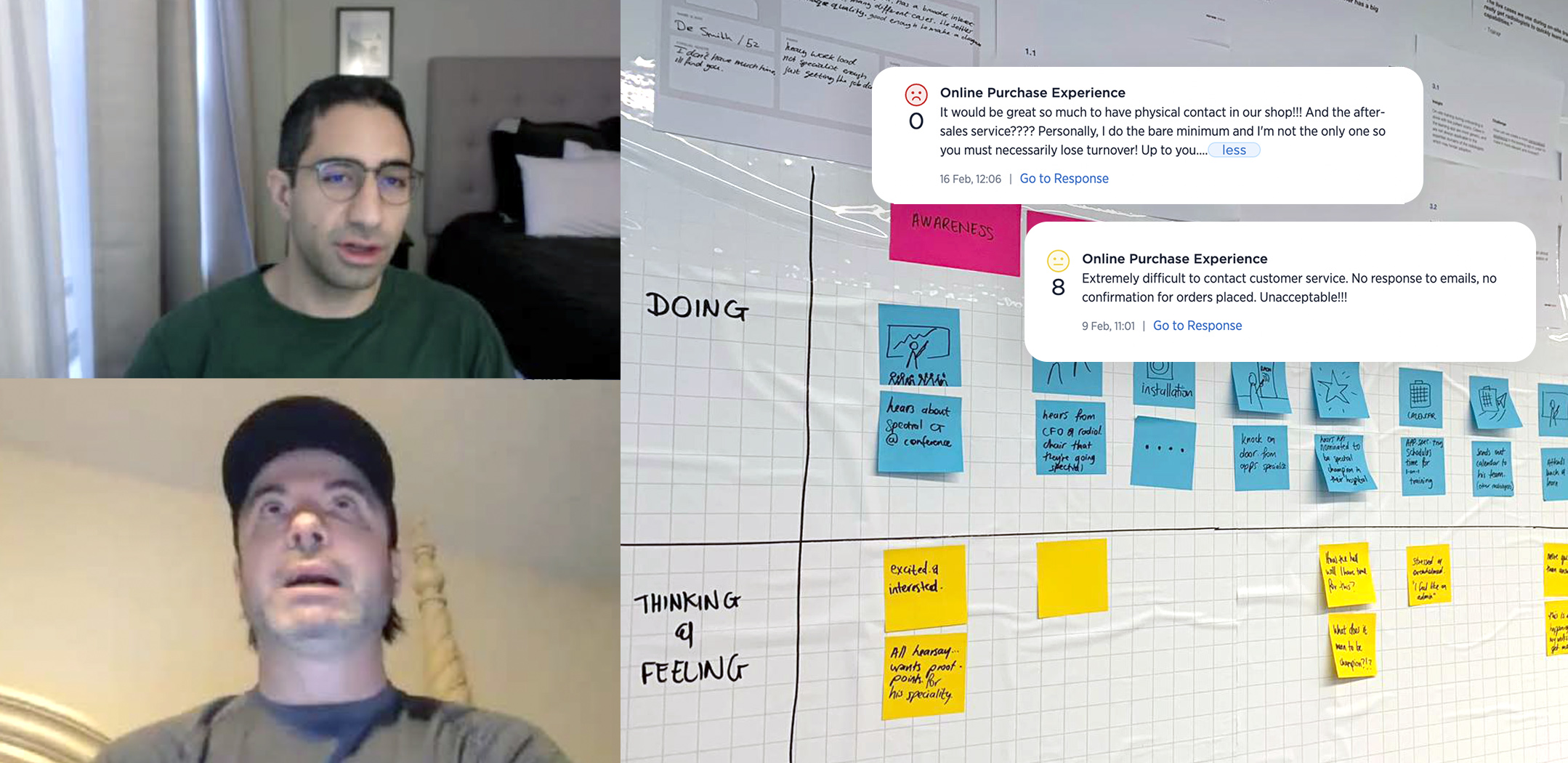
Collecting customer insights and documenting them in an experience map, deck or wiki page – in whatever format is best to share within the business. I also added these links on the blueprint so they can be easily found when people use the blueprint.
Collecting customer insights and documenting them in an experience map, deck or wiki page – in whatever format is best to share within the business. I also added these links on the blueprint so they can be easily found when people use the blueprint.
GENERATE DESIGN IDEAS
GENERATE DESIGN IDEAS
The blueprint v.1 is done. Now what?
Build a navigation system
for easy access to the tools.
The blueprint v.1 is done.
Now what?
During the mapping exercise, the team has come to realise numerous bottlenecks and risks from an organisational point of view and how this results in a lot of pain points from the users’ perspective. These are the issues to be turned into user stories in the backlog.
Here are some examples of design challenges the team started to ideate:
- How might we help customers onboard to the platform quickly?
- How might we make customers feel that they are informed when the delivery date has changed?
- How might we help customers self-serve and report an order issue without needing to call us?
The holistic view provided by the service blueprint helped the team identify broken processes and areas of improvement. This insight was used to prioritize projects on an organisation’s roadmap. Accompanied by the defined user experience map and user insights I have gathered along the process, I let the product owner, tech lead, customer support and sales representatives map epics on the blueprint so that decisions could be made, as a joint team, where to invest the budget, and efforts, depending on the results anticipated. I then planned and progressed these stories into the development cycle to improve the customer experience and have a positive impact on a business.
During the mapping exercise, the team has come to realise numerous bottlenecks and risks from an organisational point of view and how this results in a lot of pain points from the users’ perspective. These are the issues to be turned into user stories in the backlog.
Here are some examples of design challenges the team started to ideate:
- How might we help customers onboard to the platform quickly?
- How might we make customers feel that they are informed when the delivery date has changed?
- How might we help customers self-serve and report an order issue without needing to call us?
The holistic view provided by the service blueprint helped the team identify broken processes and areas of improvement. This insight was used to prioritize projects on an organisation’s roadmap. Accompanied by the defined user experience map and user insights I have gathered along the process, I let the product owner, tech lead, customer support and sales representatives map epics on the blueprint so that decisions could be made, as a joint team, where to invest the budget, and efforts, depending on the results anticipated. I then planned and progressed these stories into the development cycle to improve the customer experience and have a positive impact on a business.

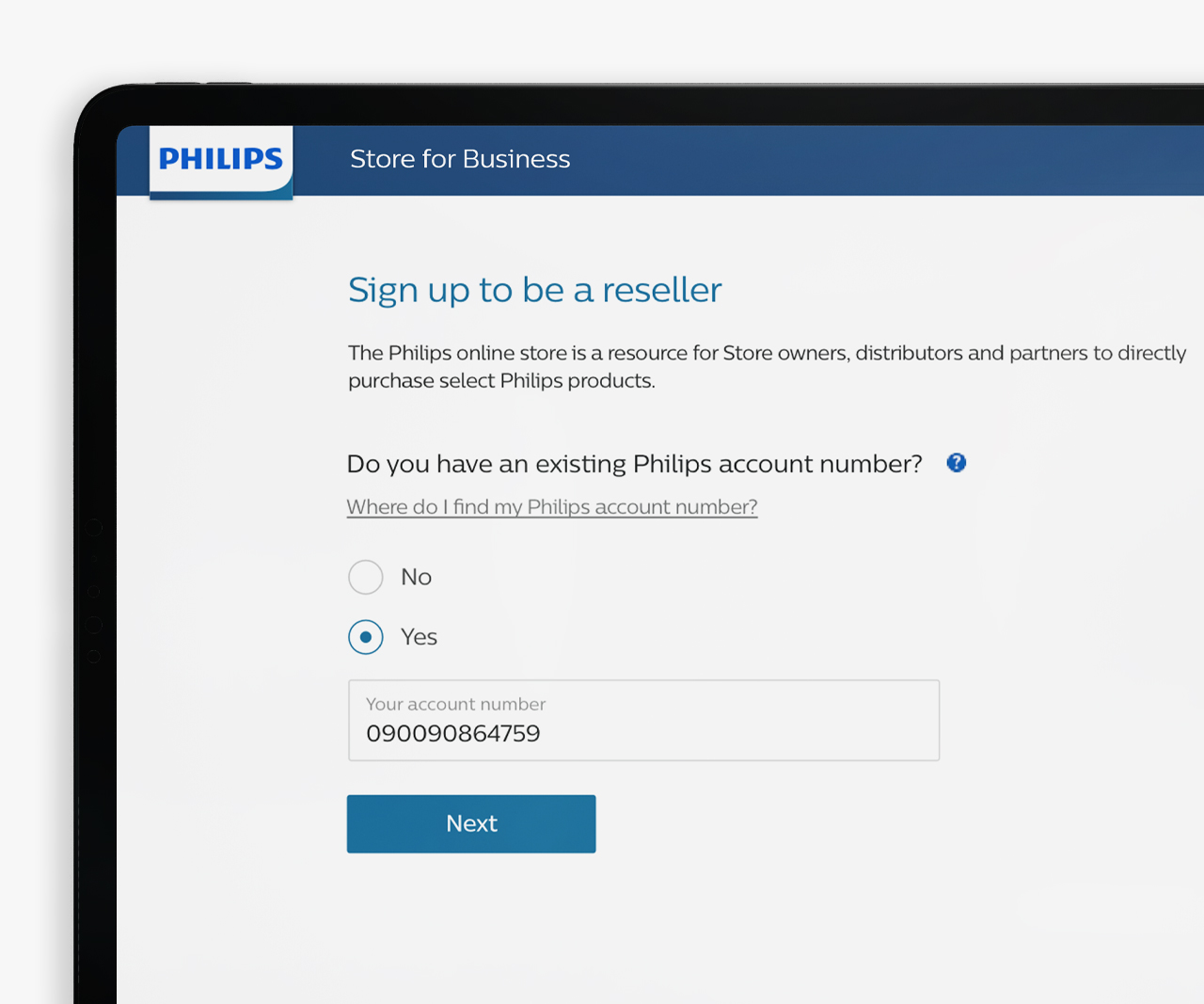
IMPACT AND LEARNING
IMPACT AND LEARNING
The bottom line.
Build a navigation system
for easy access to the tools.
The bottom line.
The service blueprint was a great tool for getting everyone aligned on how the teams came together to deliver the service. At times it could be challenging for the team to see the benefits it could bring and be convinced to reserve their time and effort – especially when there are so many moving parts and complex data flows and systems in a big organisation like Philips. However, the team came to realise the benefits the blueprint brought when they started to use it on many occasions:
- Immediately after the first draft was done, the blueprint was used by the Marketing Lead in business pitches to sell the platform to other markets – it provided a complete view of the platform to implement new strategies.
- The Product Owner and developers often use the blueprint to facilitate workshop discussions – It enabled better communication and stopped teams from making ad-hoc decisions.
I've also learnt:
- Don’t expect others to understand what you're doing from the get-go. Instead, accept that using user-centred design to solve problems is a new practice for many organisations and teams. It is up to us designers to patiently and empathetically show its value.
- If the blueprint is not being used, it needs changing. Make it visible and use it wherever the customer journey is discussed. These conversations often result in people knowing more about the customer journey or being inspired on how to improve their part of service.
- The blueprint is iterative – it requires regular reviews and updates!
The service blueprint was a great tool for getting everyone aligned on how the teams came together to deliver the service. At times it could be challenging for the team to see the benefits it could bring and be convinced to reserve their time and effort – especially when there are so many moving parts and complex data flows and systems in a big organisation like Philips. However, the team came to realise the benefits the blueprint brought when they started to use it on many occasions:
- Immediately after the first draft was done, the blueprint was used by the Marketing Lead in business pitches to sell the platform to other markets – it provided a complete view of the platform to implement new strategies.
- The Product Owner and developers often use the blueprint to facilitate workshop discussions – It enabled better communication and stopped teams from making ad-hoc decision
I've also learnt:
- Don’t expect others to understand what you're doing from the get-go. Instead, accept that using user-centred design to solve problems is a new practice for many organisations and teams. It is up to us designers to patiently and empathetically show its value.
- If the blueprint is not being used, it needs changing. Make it visible and use it wherever the customer journey is discussed. These conversations often result in people knowing more about the customer journey or being inspired on how to improve their part of service.
- The blueprint is iterative – it requires regular reviews and updates!
Selected Works

OVO EnergyEnergy billing platform

Kaluza Agent PlatformCRM platform
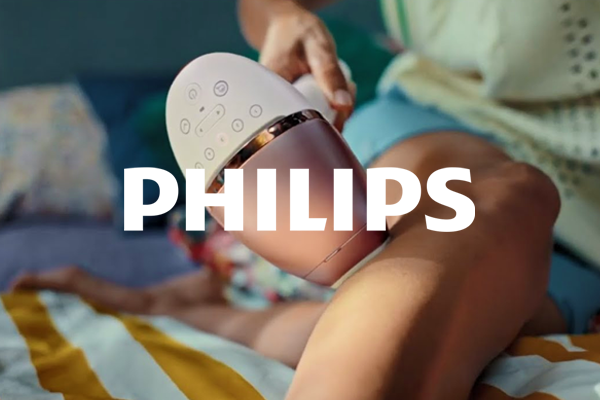
Philips Lumea appMobile APP

Philips patient monitoring systemServiceability

Align TechnologyMarketing and education tools
© 2023 FEI LIAO.